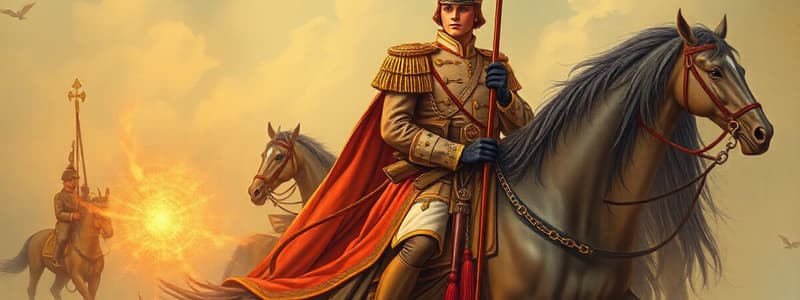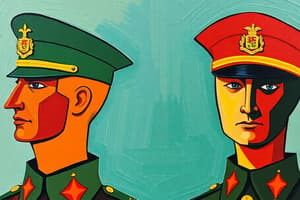Podcast
Questions and Answers
What is the primary purpose of the operations and intelligence working group?
What is the primary purpose of the operations and intelligence working group?
To coordinate and integrate information collection activities and provide recommendations to the commander.
Who typically chairs the operations and intelligence working group?
Who typically chairs the operations and intelligence working group?
The G-3 (S-3) acts as the alternate chair while the chief of staff or executive officer typically leads.
What is the primary purpose of the working group meeting?
What is the primary purpose of the working group meeting?
To synchronize information collection with operations and determine current requirements.
What is meant by 'maximum efficiency' in information collection?
What is meant by 'maximum efficiency' in information collection?
List two outputs produced by the operations and intelligence working group.
List two outputs produced by the operations and intelligence working group.
Why is preparation essential for representatives attending the working group meeting?
Why is preparation essential for representatives attending the working group meeting?
What must the G-3 (S-3) representative provide during the working group meeting?
What must the G-3 (S-3) representative provide during the working group meeting?
How does the working group help in refining the list of requirements?
How does the working group help in refining the list of requirements?
List two key responsibilities of the G-2 (S-2) representative in a working group.
List two key responsibilities of the G-2 (S-2) representative in a working group.
What role does the subordinate unit representative play in the working group?
What role does the subordinate unit representative play in the working group?
Describe the importance of reviewing friendly force information requirements.
Describe the importance of reviewing friendly force information requirements.
What is the significance of scheduling the working group cycle in alignment with higher headquarters’ battle rhythm?
What is the significance of scheduling the working group cycle in alignment with higher headquarters’ battle rhythm?
How often does the operations and intelligence working group meet?
How often does the operations and intelligence working group meet?
What are NAIs and TAIs, and why are they critical to the working group’s procedures?
What are NAIs and TAIs, and why are they critical to the working group’s procedures?
Who typically chairs the working group meeting?
Who typically chairs the working group meeting?
What is one of the essential elements that must be discussed related to information collection during the meeting?
What is one of the essential elements that must be discussed related to information collection during the meeting?
How do commanders utilize their knowledge of collection activities in planning operations?
How do commanders utilize their knowledge of collection activities in planning operations?
What is the importance of understanding specified and implied tasks for commanders?
What is the importance of understanding specified and implied tasks for commanders?
Why is terminology crucial for commanders when coordinating information collection activities?
Why is terminology crucial for commanders when coordinating information collection activities?
What are the three key points at which commanders provide formal guidance during the planning process?
What are the three key points at which commanders provide formal guidance during the planning process?
In what way do extended areas of operations (AOs) challenge a commander's information collection capabilities?
In what way do extended areas of operations (AOs) challenge a commander's information collection capabilities?
How should commanders assess and communicate the acceptable level of risk for information collection planning?
How should commanders assess and communicate the acceptable level of risk for information collection planning?
Why is it important for commanders to gain knowledge of joint and multinational vocabulary?
Why is it important for commanders to gain knowledge of joint and multinational vocabulary?
What role does the staff play in synchronizing information collection activities?
What role does the staff play in synchronizing information collection activities?
Flashcards
Operations and Intelligence Working Group
Operations and Intelligence Working Group
A group of staff representatives who coordinate and integrate information collection activities to ensure efficient use of assets and satisfy requirements.
Working Group Output
Working Group Output
The working group's output includes validating requirements, refining the list of requirements, and confirming the final disposition of all collection assets.
Working Group Reviews
Working Group Reviews
This includes reviewing friendly force information requirements, priority intelligence requirements (PIRs), and essential elements of friendly information (EEFI).
Validation of Other Working Groups
Validation of Other Working Groups
Signup and view all the flashcards
NAI & TAI Review
NAI & TAI Review
Signup and view all the flashcards
Staff Section Coordination
Staff Section Coordination
Signup and view all the flashcards
Composition of the Working Group
Composition of the Working Group
Signup and view all the flashcards
Recommendation to the Commander
Recommendation to the Commander
Signup and view all the flashcards
Working Group Meeting
Working Group Meeting
Signup and view all the flashcards
Battle Rhythm
Battle Rhythm
Signup and view all the flashcards
G-2 (S-2) Responsibilities in Working Group
G-2 (S-2) Responsibilities in Working Group
Signup and view all the flashcards
G-3 (S-3) Responsibilities in Working Group
G-3 (S-3) Responsibilities in Working Group
Signup and view all the flashcards
Frequency and Duration of Working Group
Frequency and Duration of Working Group
Signup and view all the flashcards
Working Group Leadership and Participants
Working Group Leadership and Participants
Signup and view all the flashcards
Working Group Location
Working Group Location
Signup and view all the flashcards
Working Group Purpose
Working Group Purpose
Signup and view all the flashcards
How does a commander understand the bigger picture?
How does a commander understand the bigger picture?
Signup and view all the flashcards
What happens when a unit's resources are insufficient?
What happens when a unit's resources are insufficient?
Signup and view all the flashcards
When does a commander provide guidance for information collection?
When does a commander provide guidance for information collection?
Signup and view all the flashcards
What guidance does the commander give on information collection risks?
What guidance does the commander give on information collection risks?
Signup and view all the flashcards
How does a commander understand the overall mission?
How does a commander understand the overall mission?
Signup and view all the flashcards
How should a commander view information collection activities?
How should a commander view information collection activities?
Signup and view all the flashcards
Why should a commander understand information collection activities?
Why should a commander understand information collection activities?
Signup and view all the flashcards
Who does a commander need to work with to gather information?
Who does a commander need to work with to gather information?
Signup and view all the flashcards
Study Notes
Chapter 2: Commander and Staff Roles and Responsibilities
- Commanders visualize, describe, direct, lead, and assess operations, understanding the operational environment through the common operating picture (COP) and their experience.
- Information collection (IC) and intelligence products help commanders understand the area of operations (AO).
- Commanders formulate critical information requirements (CCIRs) and ensure they remain current, vital for understanding the situation.
- Commanders engage in planning, asking the right questions, understanding enemy capabilities, and stating the commander's intent clearly.
- Commanders prioritize collection activities by providing guidance and intent early in planning.
- Commanders tie CCIRs to scheme of maneuver, considering decision points and limiting requirements to critical needs.
- Commanders aggressively seek higher echelons' collection & answers.
- Commanders identify essential elements of friendly information (EEFI), though not CCIRs, vital for protection.
- Commanders integrate intelligence preparation of the battlefield (IPB) and IC planning, ensuring staff participation for proper visualization and understanding.
- Commanders ensure IC planning and assessment are continuous, matching collection tasks to unit abilities.
- Timely reporting to analytical elements is crucial for effective IC activities.
The Commander's Needs
- Commanders need staffs to synchronize and integrate IC activities with warfighting functions, focusing on planning, preparation, execution, and assessment.
- Commanders' understanding of operational concepts, communicated as guidance to planners, dictates asset and resource allocation.
- Commanders must understand the broader operational picture, encompassing higher headquarters concepts and subordinate unit activities.
- Commanders coordinate with multiple agencies and organizations in large areas of operation (AOs).
- Commanders give guidance, including acceptable risk levels and for collection assets and required information.
- Initial guidance from commanders covers timelines, information focus, initial requirements, authorized movement, and product timelines.
Initial Planning Guidance
- Commanders provide planning guidance during mission analysis, including information collection priorities.
- This guidance supports the operations section in creating a draft IC plan.
- Commanders' planning guidance encompasses current CCIRs, operational focus, engagement criteria, and acceptable risk to assets.
The Staff's Role
- Staffs function as a cohesive unit, with each member understanding their responsibilities and duties.
- The Chief of Staff or Executive Officer manages and synchronizes staff efforts.
- The G-2 (S-2) or equivalent identifies collection requirements and implements the IC plan.
- Working groups are cross-functional teams designed for focused analysis and recommendations.
- Boards are for decisions needing higher command approval.
- Battle rhythms are synchronized cycles of command, staff, and unit activities.
Operations & Intelligence Working Group
- This group coordinates information collection efforts within operations.
- It consists of representatives from key staff sections.
- The group ensures efficient use of assets and aligns activities with the commander's intent.
Fusion Working Group
- This group fuses intelligence between command and subordinate units, refining situation templates.
Targeting Working Group
- This group coordinates targeting assets and priorities, considering intelligence and exploitation requirements.
- It ensures information collection supports target development.
Specific Information Collection Activities
- validate requirements & taskings
- identify areas of operations, confirming assets are available, and prioritizing NAIs or TAIs.
Studying That Suits You
Use AI to generate personalized quizzes and flashcards to suit your learning preferences.




